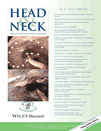Abstract
Background
There is a small subgroup of patients with head and neck cutaneous squamous cell carcinoma (cSCC) in which nodal metastases present concurrently with the primary lesion. There is evidence that these tumors may represent a more aggressive subset of cSCC. The aim of this study was to determine whether alternative clinicopathologic prognostic factors should be applied to this patient cohort.
Methods
A retrospective analysis of data from prospective databases of 2 large head and neck cancer units in Sydney, Australia, was performed. Ninety-five patients with concurrent primary and nodal metastatic head and neck cSCC were suitable for inclusion in the study.
Results
Univariable analysis was performed for overall survival (OS) and disease-specific survival (DSS). OS was adversely affected by immunosuppression (p = .011) and nodal extracapsular spread (ECS) (p = .006). Similarly, immunosuppression (p = .005) and ECS (p = .005) indicated a worse outcome for DSS. ECS and immunosuppression remained significant in the multivariable analysis.
Conclusions
This study found that adverse prognostic factors were similar to the current evidence for nonconcurrent metastatic cSCC. In particular, the primary lesion had no significant influence on survival. © 2012 Wiley Periodicals, Inc. Head Neck, 2013




